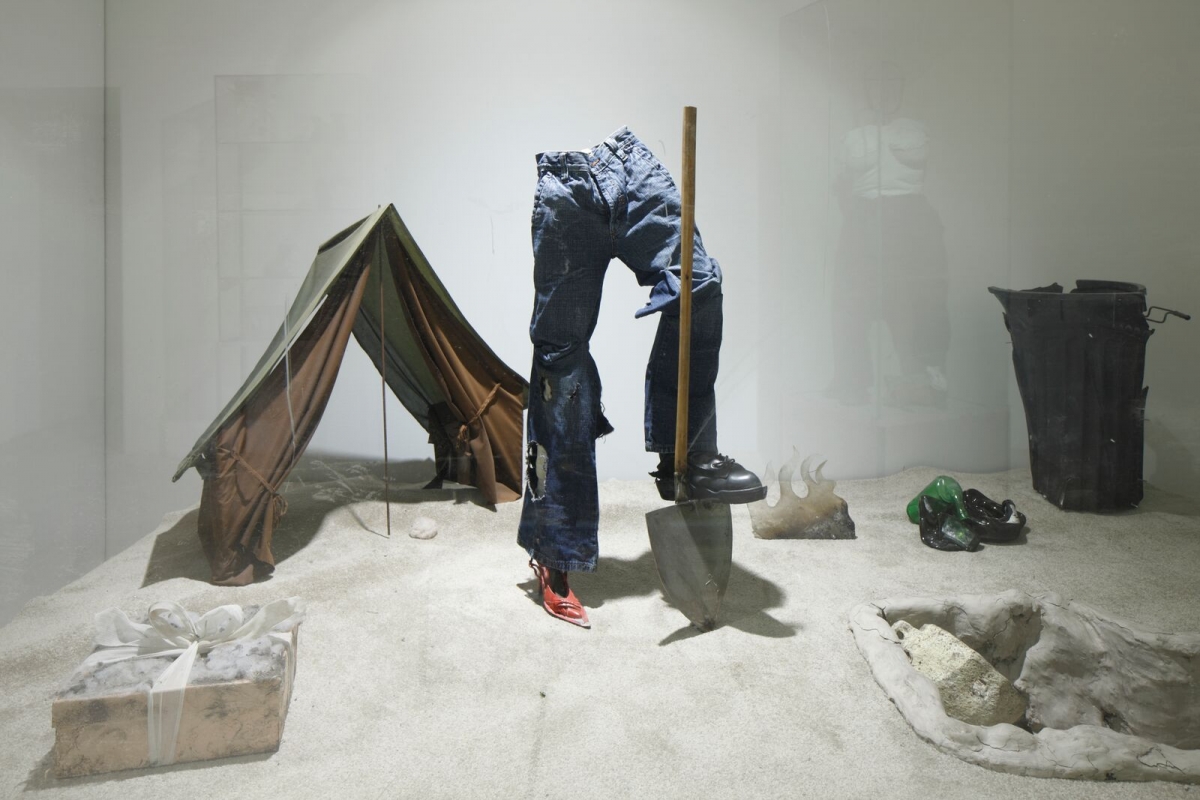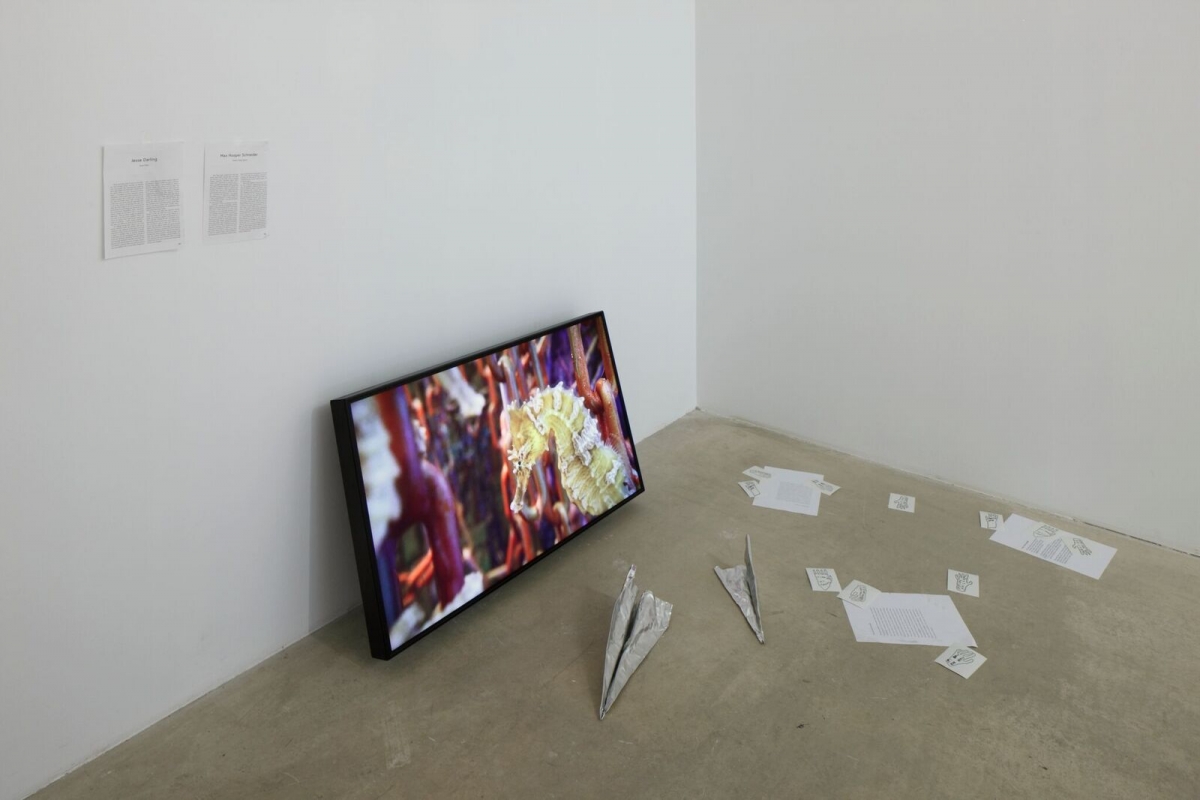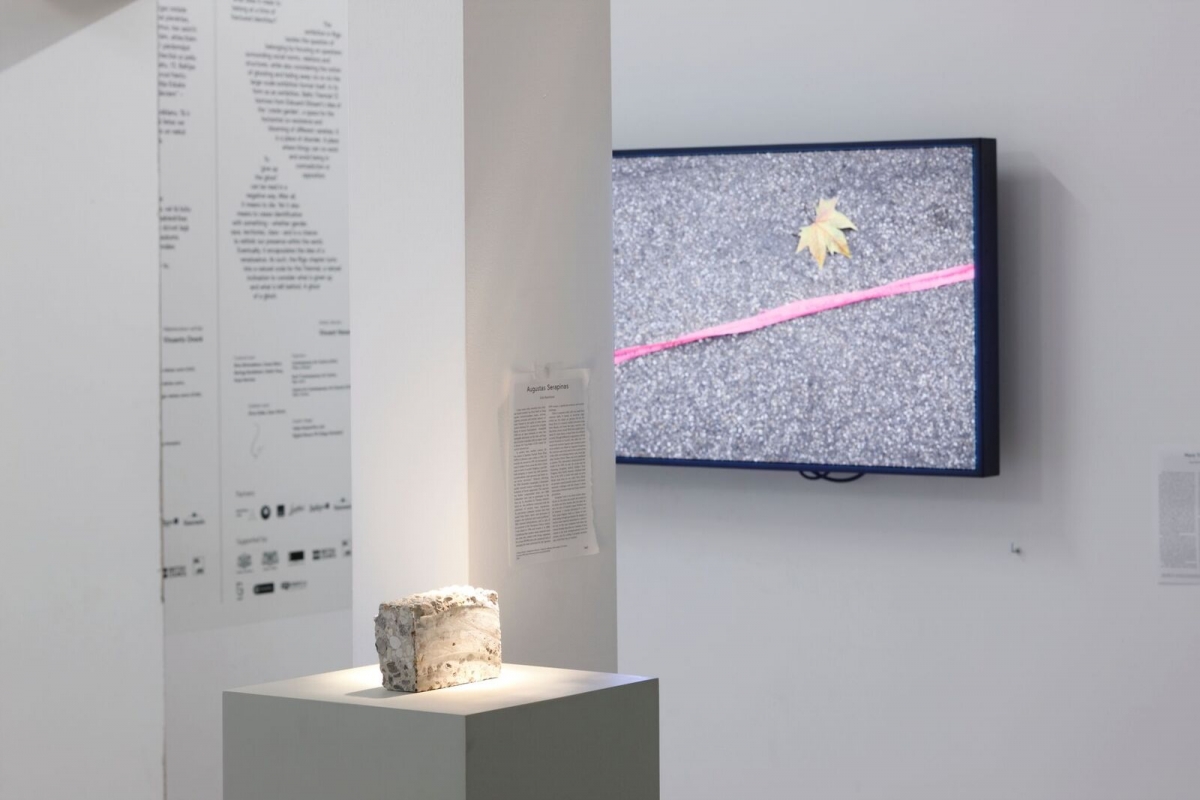
Ben Burgis and Ksenia Padan, Untitled, 2018, The Baltic Triennial 13 Give Up the Ghost, kim? contemporary art centre. Photo: Ansis Starks
The video pictures a shy mimosa: touched by the artist’s lips, the leaves of the plant fold. That is, in fact, all that the image shows for quite some time, a mimosa shrub and the artist’s touch. The video recording of a performance by Gaia Fugazza elicits detached contemplation, and prompts thoughts of the meaning of the work. The message, on the other hand, is clearly about touch, gentleness and tactility, the most immediate experience, which is also the most difficult to express conceptually. The recording of the performance is not the kind of artwork that saturates the senses of the viewer; perhaps the most direct way of communicating the immediacy of touch would be by excluding the process of thought. Distance, comparative sensual detachment and conceptually poetic word-plays, as a necessary accompaniment to the pieces, are the main features shared by the works on view at the Riga exhibition ‘Give up the Ghost’ as part of the Baltic Triennial.
Like any work of art, a work of art criticism can be a significant event in cultural politics. It is not just the institutional planning of an art event that is significant (the Triennial draws attention to the Baltic region in the centenary year of the three countries, and, in addition to Vilnius, the host city, the exhibition goes on view in Riga and Tallinn), but also the content and form of the artistic message. It is exactly the same with texts. The following lines will put forward an opinion that does not claim to be a scientifically elaborate view, nevertheless aiming to be generally useful, but not subjective. That is why any generalisation is offered for serious yet careful and critical study, even more so because I am going to avoid using the customary caveats regarding the limitations of the particular point of view: the usual ‘in my opinions’, ‘probablies’, ‘perhapses’, and so on. This kind of text makes no claim to depict the existing situation; facts are used in an exact manner, but more like quotations, to encourage further reflection. To make it the result of a conversation, I spoke with three art critics, Ieva Astahovska, Indreks Grigors and Valts Miķelsons, as I was writing it. The passages where I do not specifically refer to my interlocutors and other sources are likewise a response to matters discussed or read about.
An art event, be it a work of art or art criticism, can possess an artistic, aesthetic value; it is a cultural event, and, as I intend to argue, it is also always connected with politics as state or institutional policy, even if the work of art or art criticism does not deal directly with political matters. An art event can be politically significant on a number of levels. For instance, it can become or can be made part of the goals of a state or non-governmental institution. Many works created to mark the centenary are intended not only to provide a captivating experience or educate, but also to consolidate statehood. It is important to view the cultural-political significance of an art event not only on an institutional but also on an individual level; works are often created without any regard to cultural-political objectives, and yet they still tend to be political in their own way: the funding may be public or private, but the sponsor frequently has specific ambitions of its own. Even if we disregard the matter of funding, and take a strictly apolitical position, an art event is part of the political context, because it inevitably takes place amidst other public concerns (res publica). Art that is completely free of any institutional goals speaks of the political climate, particularly if it discusses freely things that matter to participants in art processes. Art is mostly very like citizens, whose political role becomes apparent at special moments, like national holidays, elections, protests, etc., while the rest of their time is spent living their everyday life.

Ben Burgis and Ksenia Padan, Untitled, 2018, The Baltic Triennial 13 Give Up the Ghost, kim? contemporary art centre. Photo: Ansis Starks

Ben Burgis and Ksenia Padan, Untitled, 2018, The Baltic Triennial 13 Give Up the Ghost, kim? contemporary art centre. Photo: Ansis Starks
It is worth considering the cultural-political role of the art event that the Baltic Triennial is both on an institutional and an individual level, since all the works featured in the exhibition draw attention to political or politicised subject matter. Any action by a person can be viewed as politically significant: its manifestation can be traced back to notions that are defined on the level of laws, economics and generally accepted ideas. For instance, buying vegetables in the market can be considered a political act involving interaction between the seller and the purchaser, their various identities (a farmer, lawyer, trader, cobbler), and economic status. This approach should be judged with caution, separating the politically significant from the insignificant. Significant, for instance, is the mission, defined by an art institution, to launch an international art platform, to finance from shared public resources culture that is free of any guidelines; politically significant are the objectives of exhibitions and the ways in which they are reached, while the technical aspect of the actual mounting, most likely, is not. This is why I pointed out earlier that artists tend to politicise subjects or mundane phenomena in their work. It is crucial to bear in mind that the politicisation of shopping in a market is not a one-way accomplishment; in both cases, there are gains and losses. The loss from politicisation is the blurring of the notion of politics, while the gain is the revelation that politics often deals with mundane phenomena.
Both the exhibition as a whole and the catalogue provide food for thought on the institutional mission of the event. A good example of this is a piece that, at the time of my visit, could be found near the Gaia Fugazza video: two remote-controlled Range Rover models stuffed with human hair, tufts of which were sticking out of the tiny car windows. The models can be driven around the cement floor, and it’s fun. The description of Nina Baier’s work says that the artist addresses Charles Sanders Peirce’s theory of signs, and the role of objects/representations in the liberal economy. In other words, the entertaining model cars are an interesting yet quite theoretical work on the subject of life conditions formed by the contemporary free market. According to the artist’s intention, modern-day things are like signs; they are seemingly impressive (appealing) like Range Rovers, and yet, at the same time, completely random or interchangeable. Things do not possess a constant value, or their value is a deception that evaporates soon after the purchase, and remains in the image of the advertisement/commercial. A hairpiece is a strange object, in which the authenticity of things (hair) is identical to their purely representational or substitutional function.

Ben Burgis and Ksenia Padan, Untitled, 2018, The Baltic Triennial 13 Give Up the Ghost, kim? contemporary art centre. Photo: Ansis Starks
The work in question is a bird’s-eye view, shown with the help of a specific product, of the regularities of life intertwining economic, cultural and political conditions. They are often referred to as neoliberal. The work is critical, and although neoliberal life conditions are not condemned, as you race the little models, somehow you cannot help feeling that things could be better, things could be more human. That is not to say that we have to take the work at face value, contrasting, for instance, the respective views of Gaia Fugazza and the philosopher Steven Pinker on the modern world. In one of her interviews, Fugazza speaks about urban life as pre-programmed, and limited to a few basic functions.[1] I make a mental list: work, weekday commuting, the cinema, the supermarket at weekends: the list will probably not be long. Whereas Pinker, in his ‘Enlightenment Now’, goes on and on about the benefits and advantages of the present day compared with the whole history of our civilisation; for example, there is so much more free time and more ways of spending it. ‘In the late 19th century there was not only no Internet but no radio, television, movies, or musical recordings, and for the majority of households not even a book or newspaper. For entertainment, men would go the saloon to drink.’[2]
Clearly such a striking difference between various visions has to do with the cultural-political action, goals and influence of a certain text, work of art, or institution. Fugazza’s comment makes you think of a contemplative and analytical view (or modelling alternative lifestyles); meanwhile, Pinker invites us to plunge into the flow of progress, and play an active part in shaping it. Admittedly, Pinker focuses mostly on the fruits of science, philosophy and politics in the last two centuries, and less so on art, perhaps because art is still a relatively autonomous ‘world’, one that is only indirectly linked to other areas of life. The works by Fugazza and Baier and the Baltic Triennial as a whole form a microcosm described by the art critic Valts Miķelsons as a distinctive visual language; subjects are approached in a formal and associative manner, instead of a specifically narrative one. Miķelsons believes that the Triennial offers avant-garde art, insofar as it is possible to speak of the avant-garde today: this kind of art already has a comparatively long history. Taking the liberty of drawing a couple of lines connecting works in the Triennial that are kindred to the offerings of kim? generally, I would emphasise ambiguity, marked conceptualism, a critical attitude that is sometimes merely ostensible (there is nothing behind the concepts), the poeticism of the texts, the frugality of the materiality of the works, and often amateurishness, frequently only seemingly. The Triennial and kim? invite us into a world where there are no right answers, where the works carry messages, but there is no single ‘correct’ message. It is confusing, because, is it really the way I understand it? Perhaps it is completely different? Normally, a tree is a tree and a house is a house; similarly, works of art have messages that can be understood or misunderstood. The artist Laura Prikule describes this world using a comparison from the game of tennis. There is a court, and a permanent set of rules involved in the game, but the actual play, the motives for playing and watching the game, the technology of the equipment, the ball (the idea) and the racket, as well as the playing style, vary greatly.[3] In the world created by the Triennial, an important subject under discussion is identity, to which additional cultural-political significance is added by the context of the centenary. In the radical world of the avant-garde, where there is no single correct answer, different identities can be formed and transformed as if working in plasticine. Should any concern arise regarding the Triennial as an illustration to the ‘destructive influence of liberalism on values’, there is no need to worry: it is the world of art, and it is never going to be identical to the world of life.

Ben Burgis and Ksenia Padan, Untitled, 2018, The Baltic Triennial 13 Give Up the Ghost, kim? contemporary art centre. Photo: Ansis Starks

Ben Burgis and Ksenia Padan, Untitled, 2018, The Baltic Triennial 13 Give Up the Ghost, kim? contemporary art centre. Photo: Ansis Starks
In her article about ‘playing at contemporary art’ with kim?, the art critic Alise Tīfentāle makes a number of valid points.[4] Contemporary art in Latvia has been merely played at: there should not have been any if we emphasise the character of contemporary art as a by-product of capital. The art market in Latvia is still a mere idea somewhere on the horizon of the future. The so-called avant-garde, critical and defiant of conventional norms, is not convenient either to private investment or state subsidies. And yet the existence of avant-garde art in Latvia is largely made possible, first and foremost, by state funding, and also by support from non-governmental organisations and private patronage. This kind of art is not very convenient, although, according to Tīfentāle, it is still too trouble-free, rarely aiming at genuinely sensitive spots in Latvian culture. Personally, I find works that tease or ridicule the still-inexperienced avant-garde enthusiast inconvenient enough: for instance, the inevitable scribble-covered A4 sheets of paper, put on view like paintings. Ieva Astahovska points out the unreliability of such a game, as opposed to this year’s RIBOCA offering, with its visitor-friendly geographical layout of exhibition venues, generous design, and mostly aesthetically impressive, more conventionally beautiful works, largely comprehensible without any special knowledge of art theory. The accessibility of art is a matter of cultural politics, and has to do with competition. It is important for the landscape of Latvian contemporary art that competition should work as an incentive for the players involved, instead of in conformity with the laws of survival: that the environment should be open to playing with both safe and experimental cards, that it should not force every player to choose one side or another, but rather motivate everybody to tend their own garden of contemporary art.
The Triennial exhibition in Latvia calls to mind another important subject: an uncomfortable one, but not to the extent that bringing it to light would ruin the festive mood. And the subject is an actively collaborative art scene covering the Baltic countries or a wider region, including Russia, a Russia that is well disposed towards Latvia and Europe. My interlocutors made no attempt to hide the fact that the Baltic Triennial does not hold the central place on the horizon of their interests, and it is presumably very much the same in the neighbouring countries, regarding Latvian art events that are announced as the most important in the Baltic or the Nordic region. My wish for the next hundred years is that the internationality of art events would come to be seen first and foremost in a regional context, and visiting them would seem at least as important as a pilgrimage to the Venice Biennale. Local art events are as interesting to us as we are to ourselves.

Max Hooper Schneider, “Montage on Climax Communities”, 2017, The Baltic Triennial 13 Give Up the Ghost, kim? contemporary art centre. Photo: Ansis Starks

Augustas Serapinas, part of the installation “Vygintas, Kirilas and Semionovas”, 2018, Vilnius CAC, The Baltic Triennial 13 Give Up the Ghost, kim? contemporary art centre. Photo: Ansis Starks
[1]Gaia Fugazza is interviewed by the curator Paul Luckraft http://gaiafugazza.com/resources/pdf/Paul_Luckraft_for%20Zabludowicz_Collection_2016.pdf
[2] Steven Pinker, Enlightenment Now. New York: Viking, p. 260.
[3] Laura Prikule, 99 tēzes par mākslu kā tenisa spēli in Gaidot… (Kādas idejas arheoloģija). kim? albums. Gadi Spīķeros (2009–2015), second edition. Rīga: kim? centre for contemporary art, 2017. p. 194.
[4] Alise Tīfentāle, Kā es spēlēju laikmetīgo mākslu kopā ar kim? in Gaidot… p. 183.






























